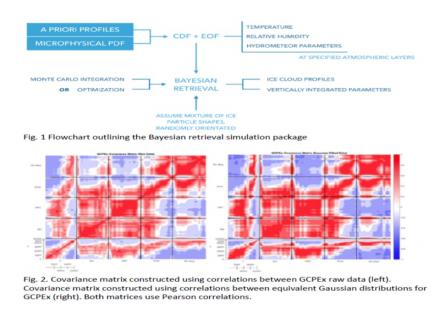Intern Student: Arushi Sinha
Mentors: Jonathan H. Jiang, Qing Yue, Kuo-Nan Liou, Yu Gu
Upper tropospheric ice particles are a window to explore the Earth’s energy balance and hydrologic cycle as they play a role in both radiative feedback and precipitation respectively. Additionally, an understanding of ice particles and the conditions in which they exist is relevant to the study of the upper tropospheric water budget, to the modelling of Earth’s weather and climate, and to the evaluation of the global circulation model. As such, a focus on the atmospheric characteristics and their relationships with ice particle parameters is important and relevant in many respects. The underlying motive behind this investigation is that real atmospheric characteristics covary with each other. These characteristics can be measured through remote sensing of the ice cloud mass. Microwave instruments are sensitive to mass; however, there is an inherent limitation due to the problem of backscattering from various sources such as cloud and atmospheric attenuation, absorption by water vapor, and most notoriously, variability in ice particle shape and size distributions. In accounting for this issue, Bayesian probability concepts may be used. This allows the a priori information to be specified within a PDF such that ice particle shape and size distributions may be modelled by specifying the likelihood of a certain combination of characteristics. Thus, a more realistic distribution of parameter values and inter-relationships can be delineated in the a priori profiles which are consequently created.
This study describes the preparation of vertical profiles and microphysical probability density functions (PDFs) from in situ cloud measurements taken in various field campaigns, the first of which discussed is the Global Precipitation Measurement (GPM) Cold-Season Precipitation Experiment (GCPEx). The profiles are of temperature, relative humidity, and three ice particle parameters, namely ice water content (IWC) —a measure of mass—, ice particle size (Dme), and the width of the size distribution (De disp.). These profiles are then transformed into cumulative density functions (CDFs) and empirical orthogonal functions (EOFs) and can be used as inputs in a Bayesian algorithm to retrieve profiles of IWC, Dme, relative humidity, and vertically integrated cloud parameters from microwave radiances and/or radar reflectivity profiles. The Ice in Clouds Experiment - Tropical (ICE-T) was the second field campaign for which this analysis was repeated. The findings from these two field campaigns are presented in this paper along with the results from a third field campaign, discussed in depth in K. F. Evans et. al. (2012): Ice cloud retrieval algorithm. This third field campaign is used as another lens for comparison.
